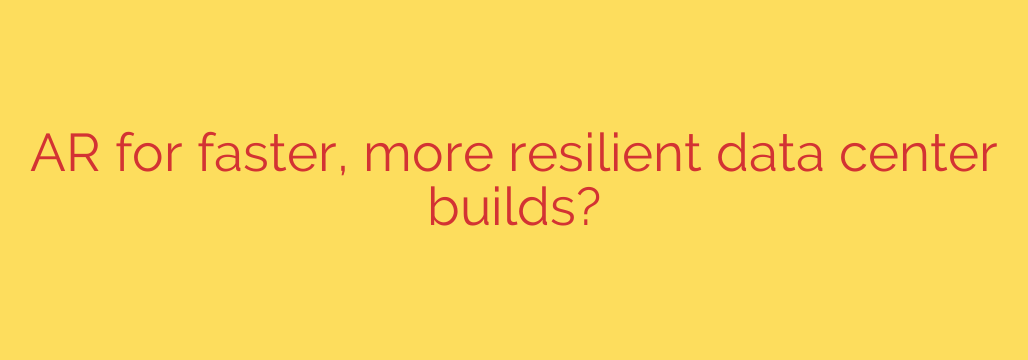
Building Tomorrow’s Infrastructure: How AR is Making Data Centers Faster and More Resilient
The relentless demand for data, cloud computing, and AI is driving an unprecedented boom in data center construction. These facilities are the backbone of our digital world, but building them is a monumental task. Projects are notoriously complex, with tight deadlines and zero tolerance for error. A single mistake in a power or cooling system can lead to costly rework, significant delays, and long-term operational risks.
Fortunately, a powerful technology is emerging to address these challenges: Augmented Reality (AR). By overlaying digital information onto the physical world, AR is transforming data center construction from a manual, error-prone process into a streamlined, precise, and highly efficient operation.
The Challenge of Modern Data Center Construction
Building a data center isn’t like constructing a typical office building. It involves integrating incredibly complex and interdependent systems, including:
- High-density power distribution
- Precision cooling and airflow management
- Extensive fiber optic and network cabling
- Physical security and fire suppression systems
Coordinating these elements requires flawless execution. Traditionally, construction crews work from 2D blueprints and 3D models on screens, constantly switching between the digital plan and the physical site. This constant translation often leads to misinterpretations, installation errors, and clashes between different systems—problems that may not be discovered until it’s too late.
Augmented Reality: A Game-Changer for Builders
Augmented Reality bridges the gap between the digital design and the physical construction site. Using a tablet or AR headset, a technician can look at an empty room and see a full-scale 3D model of the server racks, cable trays, and cooling units exactly where they are supposed to be installed.
This digital overlay provides real-time, in-context guidance that eliminates guesswork. It’s like having a digital ghost of the finished facility guiding your every move. The core technology behind this is often a Building Information Modeling (BIM) file, which is a detailed digital representation of the data center’s every component.
Key Benefits of Using AR in Data Center Builds
Integrating AR into the construction workflow delivers tangible, high-impact results that directly contribute to a faster, more resilient final product.
- Drastically Reduced Errors: By visualizing the final installation in place, workers can spot potential conflicts before they happen. For example, they can see if a newly installed pipe will block a planned cable tray. This proactive clash detection prevents rework, saving enormous amounts of time and money.
- Accelerated Project Timelines: With precise visual guidance, installations are completed faster and more accurately the first time. Technicians spend less time consulting blueprints and more time executing tasks. Finishing projects on or ahead of schedule is a significant competitive advantage.
- Enhanced Quality Assurance and Control: Project managers and inspectors can use AR to instantly compare the as-built reality with the as-designed model. By holding up a tablet, they can verify that a server rack is positioned with millimeter accuracy or that all required connections have been made. This creates a detailed and verifiable record of quality.
- Improved On-Site Safety: AR can be used to flag potential hazards in a worker’s field of view, such as live electrical conduits or areas with specific safety protocols. It also serves as an excellent training tool, providing step-by-step visual instructions for complex assembly tasks, reducing the chance of accidents.
Practical Applications on the Construction Site
The use of AR in data center builds is not just a concept; it’s being actively deployed in several key areas:
Guided Installation: A technician installing server racks can see a transparent 3D overlay of the rack, showing exactly where to drill anchor holes and make connections. This ensures perfect alignment and spacing across hundreds of units.
Remote Expert Assistance: If a local technician encounters a problem with a specialized piece of equipment, they can use their AR headset to share their point-of-view with an off-site expert. The remote expert can see what the technician sees and provide real-time guidance, annotating the live view to point out specific components or actions.
Progress Tracking and Reporting: Managers can conduct virtual walkthroughs of a site, using AR to see which components are installed and compare the progress against the project timeline. This provides stakeholders with an accurate and visual understanding of the project’s status.
The Future is Augmented
As data centers become even more complex and demand continues to surge, the need for faster, smarter, and more resilient construction methods will only grow. Augmented Reality is proving to be more than just a novelty; it is a fundamental tool for achieving the precision and efficiency required in modern infrastructure projects.
By minimizing human error, accelerating timelines, and ensuring quality from day one, AR is helping build the robust and reliable data centers that will power our digital future. The organizations that embrace this technology will not only build better facilities but will also gain a critical edge in a highly competitive market.
Source: https://datacentrereview.com/2025/08/could-ar-be-the-answer-to-faster-more-resilient-data-centre-builds/








